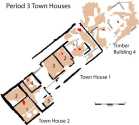
Early Roman Masonry Buildings 1 and 2 and Early Roman Timber Building 4

Early Roman Masonry Buildings 1 and 2 and Early Roman Timber Building 4
Period 3 sees major changes within the footprint occupied by Early Roman Timber Buildings 1-3. Two separate masonry town houses occupy the site of the Period 2 town house, Early Roman Timber Building 2, and the circular building, Early Roman Timber Building 3, while an enlarged Early Roman Timber Building 4 occupies the site of Early Roman Timber Building 1 and part of the site of Early Roman Timber Building 2. The overall extent of the built area does not increase, with the same clear limit at the south-western end.
The dating evidence suggests that the two new masonry buildings and Early Roman Timber Building 4 were constructed in the second quarter of the 2nd century. The latter seems to have served the same support function as was proposed for Early Roman Timber Building 1 with the principal, central hearth continuing in use. Though evidence for the structural arrangements of the building are lacking, the distinct limits of layers and surfaces in the north-east angle of the insula seems to define the extent of a building. While the two masonry buildings share very different ground-plans, there is no evidence to suppose a difference in function, which we interpret as residential. While Early Roman Masonry Building 1 has the core, three-roomed plan which is typical of many small town houses and rural villas, the square plan of Early Roman Masonry Building 2 has less obvious parallels. Is it coincidence that it fully encompasses the plan of the underlying circular building (while ERMB 1 only occupies part of the footprint of its predecessor)? One difference between the two masonry houses is that ERMB1 has produced clear evidence of metalworking, both of iron and copper alloy, from a late stage in its life, and it is possible that this may relate to a difference in status between them.
If we are correct in assuming a continuation of property boundaries, one interpretation of the changes between Periods 2 and 3 is that, if the two units which were envisaged as making up Early Roman Timber Building 2 represented the accommodation of two branches of the same family, the construction of separate houses in Period 3 simply marks a further reinforcement of that division. This of course raises a question about the proposed support role of Early Roman Timber Building 4 and whether it continued to serve both masonry buildings. In this respect the enlargement, and the associated provision of an additional hearth, may mark the establishment under the same roof of separate arrangements for each town house. It is difficult to know how to interpret the finds from Early Roman Timber Building 4 because there are not comparable deposits from the other two town houses, but a considerable quantity of ceramics, glass and animal bone was recovered from it. Although the full range of table wares, cooking wares and other domestic wares are represented, it is noticeable that decorated samian is rare. This might correlate with a lower status for the building and its occupants. Equally, the very high number of glass bottles (for serving from?) compared with the low number of drinking cups, bowls and plates might also be consistent with this interpretation of status and function.
© Internet Archaeology
URL: http://intarch.ac.uk/journal/issue21/4/p3_overview.htm
Last updated: Wed Sept 12 2007